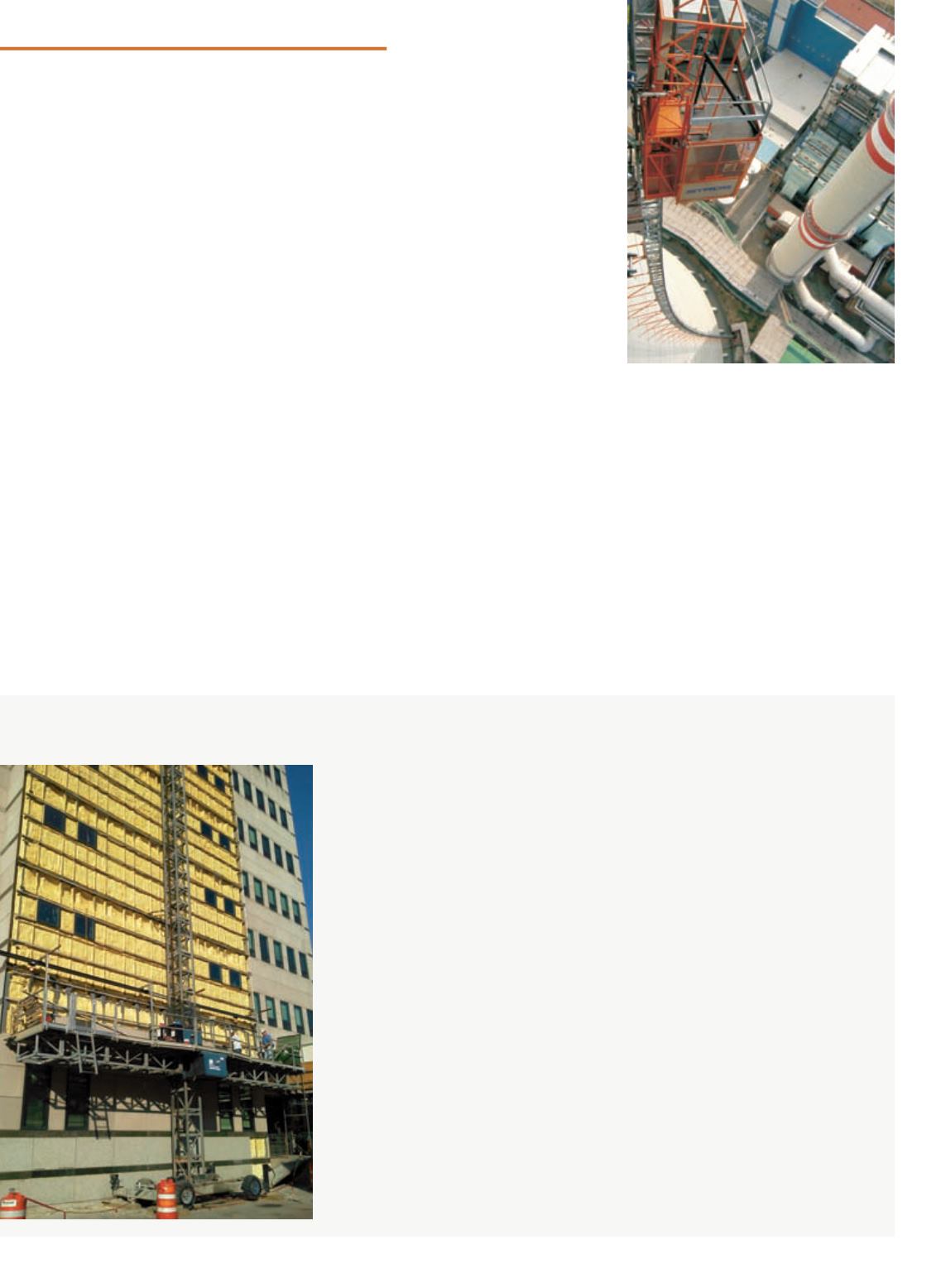
36
ALH
MAST AND HOIST SUPPLEMENT
NOVEMBER-DECEMBER 2013
MAST CLIMBING WORK PLATFORMS
Breaking down
mast climbers
We’ve covered construction hoists and transport platforms,
but what about the mast climbing work platform? Here’s a
look at the units as well as a few jobsite features.
Mast climbers complete Columbus job
K
limer Platforms recently supplied the
Cleveland Marble Mosaic Company with
a Klimer monorail system to provide
restoration and repair work on the Columbus
Safety Building project in Ohio.
Due to the building’s insulation being
improperly installed when the building was
originally built, all the limestone exterior had to
be removed for repairs to be made. Cleveland
Marble Mosaic Company used a Klimer
monorail system to remove the large pieces of
limestone. Another trade completed the spray
foam insulation and an additional trade caulked
and cleaned the building.
The Klimer product was used over
conventional scaffolding and swing stage
scaffolding to increase production and safety,
reduce ties, reduce project duration. All three
trades safely operated the equipment during
three work shifts.
In Atlanta, Mastclimbers was called upon
to come up with a delicate yet sturdy plan for
Emory Health Care. Mastclimbers had to come
up with a plan to provide 100 percent coverage,
platforms capable of lifting significant loads and
platform configurations which would provide
multi-corner profiling. Approximately 45,000
square foot pieces of Portuguese marble
and granite were mechanically anchored to
Construction Masonry Unit on two new five
story buildings, linked by a two story bridge.
In order to install the mechanical support
work which was to hold the panels, the
surveyors required to set up their measuring
equipment on continuous platforms of
significant length, and also required to take
accurate measurements between two or three
elevations separated by corners. Platforms
lengths on a single mast were able to go out
to 50-feet long.
“This type of project would not normally be
handled by mast climbing work platforms,
but the weight of the Portuguese marble and
granite façade panels was such that booms
and scissors were not suitable,” says Mike
Pitt, owner of Mastclimbers. “The platforms
were required to take loads between 6,000
and 8,000 pounds.”
At the peak of the project there were close
to 60 masons working on the platforms. Work
started in April 2012, and the project was
completed in November 2012.
■
controllers. The drive consists of electric brake
motors with gearboxes, which engage their
output pinions with the rack attached to the
mast. The safety device also engages its pinion
with the rack and will stop the unit safely should
it overspeed in the down direction.
Platform sections attach to the platform center
piece to achieve the required length. Platform
sections are equipped with handrails for safety
and convenience, and in some configurations
they can be extended toward the building
for better access. Two platform units can be
connected together and synchronized in a dual
platform configuration for extended lengths.
Main advantages
MCWPs function as a mobile scaffold. They carry
personnel and materials and their designated
purpose is to facilitate work on the outside
of a building, which differentiates them from
construction hoists and transport platforms that
primarily function as a means of transport for
people and freight.
MCWPs main advantages include extended
lifting heights and work spans, especially in
long dual platform configurations, great load
capacities and a relatively small footprint.
Because they are tied to the building, they can
lift heavy loads to great heights and thus provide
convenient and economical access during
demanding construction jobs.
■
T
he base of a mast climbing work platform
(MCWP) consists of either a frame of a
chassis. A platform unit with a frame
must be manipulated by crane, whereas a
unit on chassis could be towed, or, if the axle
is equipped with a drive, it moves on its own
around a construction site. Both options (frame
and chassis) have outriggers for leveling.
The base is a foundation for the mast, which
can be free standing for limited heights, or
tied to a building or structure. Limit cams are
mounted on the tower at the top and bottom
terminal positions and activate the normal and
final limit switches located on the main platform.
The main platform unit consists of a machinery
plate with drive motors and a safety device,
as well as electrical switches, panels and
Stros, a Czech Republic-based manufacturer
who has entered the North American market
by storm over the last few years.


